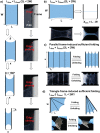Flexible Conducting Composite Film with Reversible In-Plane Folding-Unfolding Property
- PMID: 34390231
- PMCID: PMC8529486
- DOI: 10.1002/advs.202102314
Flexible Conducting Composite Film with Reversible In-Plane Folding-Unfolding Property
Abstract
Flexible conducting films in the forms of bendability or stretchability are developed as a key component to enable soft electronics. With the requirements of miniaturization and portability of modern electronics, conducting film that can endure in-plane shrinkage is urgently needed but still remains challenging. Here, a new type of conducting film achieving reversible in-plane folding-unfolding function with large deformation by infusing conductive liquids into hierarchically structured polymer films consisting of both nanostructured polymer nanofibers and microstructured frames is reported. Nanostructured polymer nanofibers that can be completely wetted by the conductive liquids provide capillary forces to gain reversible in-plane folding-unfolding property, while the microstructured frames greatly enhance the extent during folding-unfolding process. Conductivity of the produced films can be significantly improved by rationally tuning the composition of infused conductive liquids, which always keeps high values during the folding-unfolding deformation. It is believed that this work may serve as the basis for robust fabrication of flexible conducting films with reversible in-plane folding-unfolding function, and can also put one-step forward of modern soft electronics.
Keywords: flexible conducting films; in-plane folding-unfolding; reversible deformation; soft electronics.
© 2021 The Authors. Advanced Science published by Wiley-VCH GmbH.
Conflict of interest statement
The authors declare no conflict of interest.
Figures




References
-
- a) Yang J. C., Mun J., Kwon S. Y., Park S., Bao Z., Park S., Adv. Mater. 2019, 31, 1904765; - PubMed
- b) Cao Y., Tan Y. J., Li S., Lee W. W., Guo H., Cai Y., Wang C., Tee B. C. K., Nat. Electron. 2019, 2, 75;
- c) Pan S., Zhang F., Cai P., Wang M., He K., Luo Y., Li Z., Chen G., Ji S., Liu Z., Loh X. J., Chen X., Adv. Funct. Mater. 2020, 30, 1909540;
- d) Lei Z., Wu P., Nat. Commun. 2018, 9, 1134. - PMC - PubMed
-
- a) Chiang C. K., Fincher C. R., Park Y. W., Heeger A. J., Shirakawa H., Louis E. J., Gau S. C., MacDiarmid A. G., Phys. Rev. Lett. 1977, 39, 1098;
- b) Shirakawa H., Louis E. J., MacDiarmid A. G., Chiang C. K., Heeger A. J., J. Chem. Soc., Chem. Commun. 1977, 578.
Publication types
Grants and funding
LinkOut - more resources
Full Text Sources
